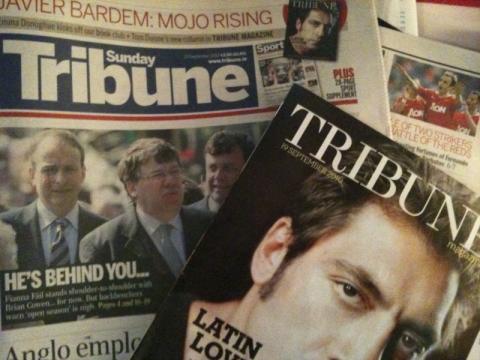Sunday Tribune redesigned to target new readers

The Sunday Tribune will be published in full-colour tabloid henceforth. The compact design launched today aspires to attract new readers, particularly women and younger readers. The paper lost €5m in 2008 and is expected to have lost at least that sum in 2009, mainly because of flagging advertising revenue and declining sales.
The new-look frontpage is distinctive on newspaper stands. It gives the impression of being more compact than its broadsheet competitors, and its design is quite apart from other tabloids which tend to use dazzling double-colour. The paper appears to contain no less content than the old broadsheet format.
The contents panel on page 2 is a bit of a mess and could be designed in a similar way to the Sunday Times contents panel. But the main news section is wonderfully laid out. Great use is made of full colour; photographs pepper each page, they are well-sized and well-spaced and draw the reader's eye across the page to each story. The redesign makes use of white space, so colourful photos with defined edges are more effective than photos with lighter backdrops. A colourful photo-feature of bee-keepers in Africa fills two pages in the centre of the main section: opportunities for travelling photo journalists to publish their work here in future?
The design of the news section is slightly similar to the Irish Independent tabloid edition, though fonts are different. The pages tend to be squarely designed, photos and other content doesn't break across lines or columns. The UK-based media consultant Louis Jebb worked in Dublin on this redesign with the Tribune's in-house designer Joe Coyle. A member of Tribune staff said that Jebb also worked on the Irish Independent tabloid design.
There is good variation in the length of the news stories, with denser news features toward the end of the news section. The main paper merges news, comment and opinion, features and business. A distinctive strap is used for full page opinion pieces; Diarmuid Doyle is promoted to page 13, Una Mullally on page 27, and there is a Perspectives section from page 37 to 42.
The font is retained from the old broadsheet design, though it has been reduced in size by 0.4 which tightens the text; there is a risk this might frustrate bespectacled folk.
Today's edition contains a long extract on from Michael Clifford and Shane Coleman's new book 'Scandal Nation'. The feature examines Ben Dunne, Michael Lowry and Charlie Haughey's money. A lengthy interview with Brian Lenihan is also published. These longer features could do with some more design 'entry points' that draw the reader into the story; the Irish Times and Guardian use small panels containing relevant statistics that break up the feature and draw the eye through the text.
Sport retains its own supplement. Today's edition runs a lengthy interview with golfer Padraig Harrington and contains a pullout for the All Ireland Final between Cork and Down.
Surveys indicated a low female readership of the Sunday Tribune, and it is hoped that the reintroduction of a glossy magazine will change this. Actor Javier Bardem (who I'm told is a hunk) is on the cover of the magazine. He also appears the front page above a somewhat dated story of Lady Gaga's latest shock tactic – wearing a garment made of raw meat.
The back page of the main supplement gives another snapshot of the main news features and two stories highlighted here are also intended to draw a female audience; a colourful photo advertises a story on high-heels while a food item on brownies is advertised beneath.
Very few new contributors appear in the paper. The magazine contains a new column by broadcaster and musician Tom Dunne, but the news line-up is unchanged. The Sunday Tribune has several fine journalists, but this is nonetheless disappointing and a further example of celebrity clique in Irish print media. His magazine billing indicates that Dunne will contribute to the lighter side of the paper; perhaps this is a direction the paper wishes to take and it might draw a younger readership. But this is a lost opportunity to bring in other lesser-known journalists doing interesting newsworthy work that could have added to the paper's identity, it's website and could have supplemented Ken Foxe's great investigative journalism of the past year (the expenses scandal). The folks at thestory.ie for example, who FOI the hell out of public documents and draw together the information in meaningful ways. The Tribune is not unaware of these people; today's edition ran a feature on six Irish bloggers including Suzie Byrne, another good writer.
The last redesign of the Sunday Tribune won a European Press award, though it vacillated in certain design aspects thereafter. Women readers were targeted again in 2009 by a 48-page glossy magazine, but this was subsequently replaced in March or April this year by a supplement that was cheaper to print. The Arts supplement was also combined within another section of the paper at that time.
Readership of the Sunday Tribune was reported to have dropped 30 per cent in 2008. Copies of the paper were freely circulated to homes in designated urban areas this year, yet readership fell to June 2010 had fallen again, though only by three per cent to 167,000 readers each week. Management at the paper have dropped plans to place online content behind a paywall; perhaps this should be reconsidered as online readership must surely account for some of the drop off in sales.
INM in Newry (who prints the Tribune) couriered advance copies to a pub on Talbot Street last night where Tribune staff awaited the new-look paper. It's a job well done, but will readers appreciate it? Past experience (with the glossy magazine and other reconfigurations) suggests that a strong marketing campaign must accompany the new format to increase sales.
